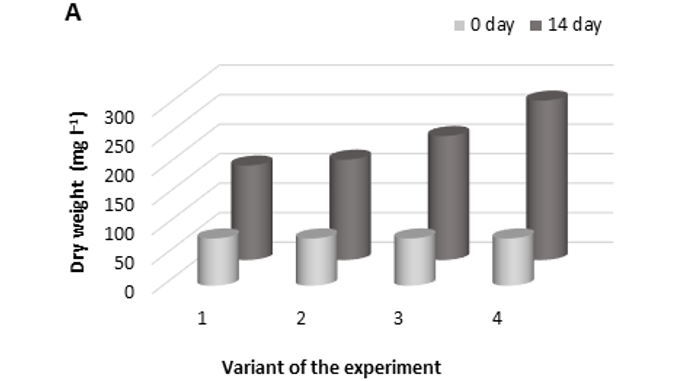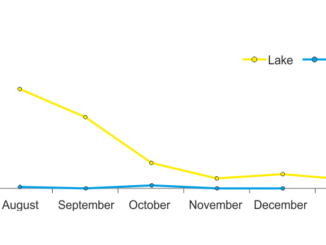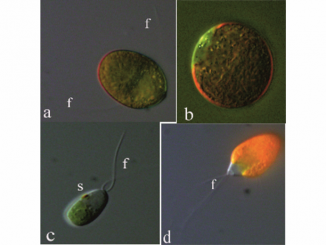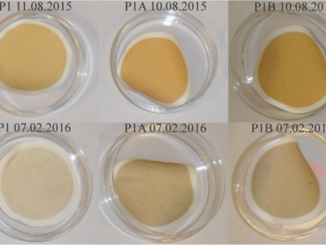
Paper category: Original research paper
Corresponding author: Inna Nezbrytska (inna_imn@ukr.net)
DOI: https://doi.org/10.26881/oahs-2022.1.05
Received: 13/08/2021
Accepted: 11/10/2021
Full text: here
Citation (APA style): Nezbrytska,I.,Shamanskyi,S.,Pavliukh,L. & Kharchenko,G.(2022).Assessment of inorganic nitrogen and phosphorus compounds removal efficiency from different types of wastewater using microalgae cultures. Oceanological and Hydrobiological Studies,51(1) 45-52. https://doi.org/10.26881/oahs.2022.1.05
Abstract
The efficiency of ammonium nitrogen (N-NH4+) and phosphate (P-PO43-) removal from wastewater with different loads of these nutrients was evaluated using Chlamydomonas reinhardtii (Сhlоrорhуtа) and Oscillatoria neglecta (Суаnорhуtа/Cyanoprokaryota). In addition, functional characteristics of the microalgae under the studied conditions were determined. It was demonstrated that Ch. reinhardtii is resistant to a wide range of concentrations of inorganic nitrogen and phosphorus compounds. Microalgae actively participate in the removal of N-NH4+ from wastewater (removal efficiency of 49–63%, depending on the initial concentration). At the same time, Ch. reinhardtii showed low levels of P-PO43- removal (7–18%) from the aquatic environment. O. neglecta, unlike Ch. reinhardtii, is sensitive to excessively high concentrations of N-NH4+ (90–140 mg l-1) and P-PO43- (26–90 mg l-1). However, it is characterized by high removal efficiency for both forms of nitrogen (60–61%) and phosphorus (43–55%) at their initial concentrations of 30–50 mg l-1 and 7–14 mg l-1, respectively. Therefore, O. neglecta is best suited for use in wastewater post-treatment.
References
Abdel-Raouf, N., Al-Homaidan, A. A., & Ibraheem, I. B. (2012). Microalgae and wastewater treatment. Saudi Journal of Biological Sciences, 19(3), 257–275. https://doi.org/10.1016/j.sjbs.2012.04.005 PMID:24936135
Abou-Shanab, R. A. I., Ji, M.-K., Kim, H.-C., Paeng, K.-J., & Jeon, B.-H. (2013). Microalgal species growing on piggery wastewater as a valuable candidate for nutrient removal and biodiesel production. Journal of Environmental Management, 115, 257–264. https://doi.org/10.1016/j.jenvman.2012.11.022
Acevedo, S., Pino, N. J. & Peñuela, G. A. (2017). Biomass production of Scenedesmus sp. and removal of nitrogen and phosphorus in domestic wastewater. Ingeniería Y Competitividad. 19 (1), 185–193.
Arsan, O.M., Davydov, O.A., Dyachenko, T.M., Yevtushenko, N. Yu., Zhukinskiy, V. M., Kyrpenko, N. I., Klenus, V. H., Kipnis, L. S., Lynnyk, P. M., Konovets, I. M., Lyashenko, A. V., Olshnyk, H. M., Pashkova, O. V., Protasov, O. O., Sylaeva, A. A., Sytnyk, Yu. M., Stoika, Yu. O., Tymchenko, V. M., Shapoval, T. M., Shevchenko, P. H., Shcherbak, V. I., Yuryshynets, V. I., Yakushyn, V.M. (2006). Metody gidroekologichnykh doslidzhen poverkhnevykh vod. (Methods of hydroecological investigations of surface waters.). Logos Press.
Aslan, S., & Kapdan, I. K. (2006). Batch kinetics of nitrogen and phosphorus removal from synthetic wastewater by algae. Ecological Engineering, 28(1), 64–70. https://doi.org/10.1016/j.ecoleng.2006.04.003
Bhatnagar, A., Chinnasamy, S., Singh, M., & Das, K. C. (2011). Renewable biomass production by mixotrophic algae in the presence of various carbon sources and wastewaters. Applied Energy, 88(10), 3425–3431. https://doi.org/10.1016/j.apenergy.2010.12.064
Cai, T., Park, S. Y., & Li, Y. (2013). Nutrient recovery from wastewater streams by microalgae: Status and prospects. Renewable & Sustainable Energy Reviews, 19, 360–369. https://doi.org/10.1016/j.rser.2012.11.030
Dyhrman, S. T. (2016). Nutrients and their acquisition: Phosphorus physiology in microalgae. In M. A. Borowitzka, J. Beardall & J. Raven (Eds.), The Physiology of Microalgae (pp. 155–183). Springer International Publishing. https://doi.org/10.1007/978-3-319-24945-2
Eladel, H., Esakkimuthu, S., & Abomohra, A. (2019). Dual role of microalgae in wastewater treatment and biodiesel production. In S. K. Gupta & F. Bux (Eds.), Application of microalgae in wastewater treatment (pp. 85–121). Springer. https://doi.org/10.1007/978-3-030-13909-4_5
European Commission. (2016). Eighth report on the implementation status and the programmes for implementation (as required by Article 17) of Council Directive 91/271/EEC concerning urban waste water treatment. COM (2016) 105.
Fernandes, T. V., Suárez-Muñoz, M., Trebuch, L. M., Verbraak, P. J., & Van de Waal, D. B. (2017). Toward an Ecologically Optimized N:P Recovery from Wastewater by Microalgae. Frontiers in Microbiology, 8, 1742. https://doi.org/10.3389/fmicb.2017.01742 PMID:28955317
Grobbelaar, J. U. (2004). Algal Nutrition − Mineral Nutrition. In A. Richmond (Ed.), Handbook of Microalgal Culture: Biotechnology and Applied Phycology (pp. 97–115). Blackwell Publishing Ltd.
Henze, M., Harremoës, P., Jansen, J. L. C., & Arvin, E. (2002). Wastewater treatment. Biological and chemical processes. Springer.
Jeffrey, S., & Humphrey, F. H. (1975). New spectrophotometric equations for determining chlorophyll a, b, c1 and c2 in higher plants, algae and natural phytoplankton. Biochemie und Physiologie der Pflanzen, 167(2), 191–194. https://doi.org/10.1016/S0015-3796(17)30778-3
Kong, Q. X., Li, L., Martinez, B., Chen, P., & Ruan, R. (2010). Culture of microalgae Chlamydomonas reinhardtii in wastewater for biomass feedstock production. Applied Biochemistry and Biotechnology, 160(1), 9–18. https://doi.org/10.1007/s12010-009-8670-4 PMID:19507059
Krzemińska, I., Pawlik-Skowrońska, B., Trzcińska, M., & Tys, J. (2014). Influence of photoperiods on the growth rate and biomass productivity of green microalgae. Bioprocess and Biosystems Engineering, 37(4), 735–741. https://doi.org/10.1007/s00449-013-1044-x PMID:24037038
Lim, S. L., Chu, W. L., & Phang, S. M. (2010). Use of Chlorella vulgaris for bioremediation of textile wastewater. Bioresource Technology, 101(19), 7314–7322. https://doi.org/10.1016/j.biortech.2010.04.092 PMID:20547057
Madkour, A. G., Rasheedy, S. H., Dar, M. A., Farahat, A. Z., & Mohamed, T. A. (2017). The differential efficiency of Chlorella vulgaris and Oscillatoria sp. to treat the municipal wastewater. Journal of Biology, Agriculture and Healthcare, 7(22), 83–94.
Markou, G., Vandamme, D., & Muylaert, K. (2014). Microalgal and cyanobacterial cultivation: The supply of nutrients. Water Research, 65, 186–202. https://doi.org/10.1016/j.watres.2014.07.025 PMID:25113948
Mau, L., Kant, J., Walker, R., Kuchendorf, C. M., Schrey, S. D., Roessner, U., & Watt, M. (2021). Wheat Can Access Phosphorus From Algal Biomass as Quickly and Continuously as From Mineral Fertilizer. Frontiers in Plant Science, 12, 631314. https://doi.org/10.3389/fpls.2021.631314 PMID:33584779
Mohsenpour, S. F., Hennige, S., Willoughby, N., Adeloye, A., & Gutierrez, T. (2021). Integrating micro-algae into wastewater treatment: A review. The Science of the Total Environment, 752, 142168. https://doi.org/10.1016/j.scitotenv.2020.142168 PMID:33207512
Moudříková, Š., Nedbal, L., Solovchenko, A., & Mojzeš, P. (2017). Raman microscopy shows that nitrogen-rich cellular inclusions in microalgae are microcrystalline guanine. Algal Research, 23, 216–222. https://doi.org/10.1016/j.algal.2017.02.009
Nezbritskaya, I. N., Kureyshevich, A. V., Yarovoy, A. A., Potrokhov, A. S., & Zin’kovskiy, O. G. (2019). Peculiarities of the Influence of High Concentrations of Ammonium on the Functioning of Some Species of Cyanoprokaryota, Chlorophyta, and Euglenophyta. Hydrobiological Journal, 55(2), 69–82. https://doi.org/10.1615/HydrobJ.v55.i2.60
Nezbritskaya, I. N., & Kureyshevich, A. V. (2015). Changes in the Content of Photosynthetic Pigments in Representatives of Chlorophyta and Cyanoprokaryota at a High Temperature. Hydrobiological Journal, 51(4), 46–56. https://doi.org/10.1615/HydrobJ.v51.i4.60
Parsons, T. R., & Strickland, J. D. H. (1963). Discussion of spectrophotometric determination of marineplant pigments and carotinoids. Journal of Marine Research, 21(3), 155–163.
Powell, N., Shilton, A., Pratt, S., & Chisti, Y. (2011). Luxury uptake of phosphorus by microalgae in full-scale waste stabilisation ponds. Water Science and Technology, 63(4), 704–709. https://doi.org/10.2166/wst.2011.116 PMID:21330717
Rawat, I., Ranjith Kumar, R., Mutanda, T., & Bux, F. (2011). Dual role of microalgae: Phycoremediation of domestic wastewater and biomass production for sustainable biofuels production. Applied Energy, 88(10), 3411–3424. https://doi.org/10.1016/j.apenergy.2010.11.025
Razzak, S. A., Hossain, M. M., Lucky, R. A., Bassi, A. S., & de Lasa, H. (2013). Integrated CO2 capture, wastewater treatment and biofuel production by microalgae culturing—A review. Renew. Renewable & Sustainable Energy Reviews, 27, 622–653. https://doi.org/10.1016/j.rser.2013.05.063
Renuka, N., Sood, A., Prasanna, R., & Ahluwalia, A. S. (2015). Phycoremediation of wastewaters: A synergistic approach using microalgae for bioremediation and biomass generation. International Journal of Environmental Science and Technology, 12, 1443–1460. https://doi.org/10.1007/s13762-014-0700-2
Rowan, K. S. (1989). Photosynthetic Pigments of Algae. Cambridge University Press.
SCOR-UNESCO. (1966). Determination of Photosynthetic Pigments. Monographs on Oceanographic Methodology 1. Paris: UNESCO.
Shamanskyi, S. I., & Boichenko, S. V. (2018). Environment-Friendly Technology of Airport’s Sewerage. In T. Karakoç, C. Colpan, & Y. Şöhret (Eds.), Advances in Sustainable Aviation (pp. 161–175). Springer. https://doi.org/10.1007/978-3-319-67134-5_11
Silva, N. F. P., Gonçalves, A. L., Moreira, F. C., Silva, T. F. C. V., Martins, F. G., Alvim-Ferraz, M. C. M., Boaventura, R. A. R., Vilar, V. J. P., & Pires, J. C. M. (2015). Towards sustainable microalgal biomass production by phycoremediation of a synthetic wastewater: A kinetic study. Algal Research, 11, 350–358. https://doi.org/10.1016/j.algal.2015.07.014
Solovchenko, A. E., Lukyanov, A. A., Vasilieva, S. G., Savanina, Ya. V., Solovchenko, O. V., & Lobakova, E. S. (2013). Possibilities of Bioconversion of Agricultural Waste with the Use of Microalgae. Moscow University Biological Sciences Bulletin, 68(4), 206–215. https://doi.org/10.3103/S0096392514010118
Su, Y. (2021). Revisiting carbon, nitrogen, and phosphorus metabolisms in microalgae for wastewater treatment. The Science of the Total Environment, 762, 144590. https://doi.org/10.1016/j.scitotenv.2020.144590 PMID:33360454
Thomas, D., Minj, N., Mohan, N., & Rao, P. H. (2016). Cultivation of Microalgae in Domestic Wastewater for Biofuel Applications – An Upstream Approach. Journal of Algal Biomass Utilization, 7(1), 62–70.
Zabochnicka-Świątek, M., Malinska, K., & Krzywonos, M. (2014). Removal of biogens from synthetic wastewater by microalgae. Environment Protection Engineering, 40(2), 87–104. https://doi.org/10.37190/epe140207



